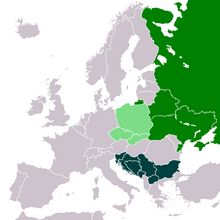Eastern Slavs
Eastern Slavs are a branch of the Slavs , today Russians , Ukrainians , Belarusians and Russians , whose languages belong to the group of East Slavic languages .
Allocation is based on linguistic and material-cultural criteria and is not always clear for the period up to the 10th century.
Settlement area
The settlement area of the Eastern Slavs stretched in the High Middle Ages from Eastern Poland to the Black Sea in the south and Lake Ilmen in the north. They bordered West Slavic tribes in the west, Baltic tribes in the north-west, Finno-Ugric tribes in the north and north - east, Turkic tribes in the south and South Slavic tribes in the south-west .
In the course of the advancing Slavic settlement in the east, Baltic and Finno-Ugric tribes were assimilated in the central Russian area.
history
Since the late 6th century, Slavic tribes settled along major rivers such as the Dnieper , Pripyat, and Dniester .
There are very few written statements about the origins and spread of East Slavic tribes.
Mentions
Bavarian geographer
around 850/890
- Bushans on the western bow
- Ulitschen between the Dnieper and the Southern Bug
- Tiwerzen
Nestor Chronicle to
around 864
- Ilmensee Slovenes on the Ilmensee near Novgorod and on the Volkhov
- Kriwitschen on the Daugava near Polatsk
at 885
- Poljanen on the Dnieper near Kiev ,
- Drewlanen on the lower Pripyat near Iskorosten
- Severyanen near Chernihiv
- Radimitschen on the upper Dnepr and Desna
907
- Choir wading on the lower Dniester
- Duleben on the western bow
- Vyatich on the Oka near Moscow
10th century
- Dregovich on the middle Pripyat near Turow
- Volhynians the Western Bug to Volyn and Vladimir
Kievan Rus
Around 864, Scandinavian Varangians began their rule in the area around Novgorod and Ladoga . The Slavic Ilmensee Slovenes and Kriwitschen were among the first mentioned tribes . In the decades that followed, the Rus expanded their territory over numerous other Slavic tribes.
From 988 she took over Orthodox Christianity according to the Byzantine rite. The Cyrillic script became common .
Division of the area
From 1340 the western areas came under the rule of the Grand Duchy of Lithuania and the Kingdom of Poland . The eastern areas initially remained under the influence of the Golden Horde .
Cultural differences began to develop. The Ruthenian language was spoken in the Grand Duchy of Lithuania and became the precursors of Ukrainian and Belarusian . The Russian language developed in the east .
From 1480
After the liberation of the eastern part of the Rus from Tatar rule, a rivalry developed between the Grand Duchies of Moscow and Lithuania to reunite the Eastern Slavs under their rule. As part of this rivalry, there were several Russian-Lithuanian and Russian-Polish wars.
The Russian Empire succeeded in conquering almost all East Slavic territories except for Galicia .
As part of the conception that was common around the world before the October Revolution , all Eastern Slavs were referred to as Russians and divided into Great Russians , Little Russians , and Belarusians . During the Soviet era, Great Russians became Russians and Minor Russians became Ukrainians. Some ethnologists consider the Russians to be a fourth East Slavic people.
Today the Eastern Slavs make up the largest group of Slavs with almost 200 million people.
Way of life
The East Slavs spoke the Old East Slavic language . They lived from agriculture and hunting, and they started to found cities and castles at an early age. That is why their area, through which important trade routes ran along the branched river system, was called Gardarike , the 'realm of cities' in Old Norse usage .
See also
literature
- Frank Kämper: Eastern Slaves . In: Lexicon of the Middle Ages (LexMA). Volume 6, Artemis & Winkler, Munich / Zurich 1993, ISBN 3-7608-8906-9 , Sp. 1546-1549.
Remarks
- ↑ The independence of Kosovo is not yet taken into account on this map. Kosovo has an Albanian-speaking majority of the population.
- ↑ "И бъ Олегъ обладав поляны, и деревляны, и съверяны, и радимичи, а съ суличи и тиверци имеаша рать" , Nestorchronik, tributary strains
- ↑ "Иде Олегъ на Грекы. (...) поя множество варяг, и словенъ, и чюд (и) и словене, и кривичи, и мерю, и деревляны, и радимичи, и поляны, и съверо, и вятич (и ), и хорваты, и дулъбы, и тиверци "


